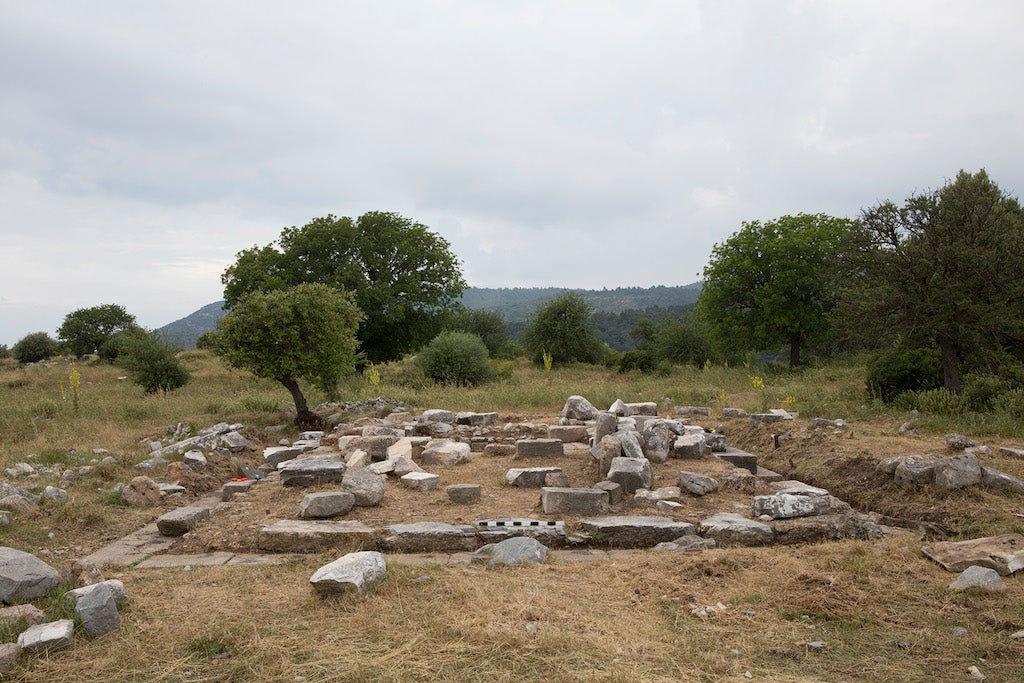C. Schuchhardt
The first modern scholar to study Notion in detail was the German C. Schuchhardt, who was also the first to secure the identification of the site. Schuchhardt made several visits to the Hales River valley in 1885 and 1886, and in 1886 he published the results of his investigations, including a map of Notion, an elevation drawing of a well-preserved portion of the fortification walls, a very rough plan of a temple, and a plan and elevation drawing of a rectangular building that would later be identified as the city’s Bouleuterion. Schuchhardt also recorded and published several inscriptions from Gâvurköy (the early modern name of Ahmetbeyli).
Th. Macridy
In 1897 and then again in 1904, Th. Macridy visited Gâvurköy and surroundings. Macridy was the first to conduct proper archaeological excavations in Notion, Klaros, and Kolophon. In 1905 and 1907, he published two reports on the antiquities of Notion, where he excavated and documented a Byzantine church (75 m east of the Bouleuterion), architectural fragments from different buildings and periods, a selection of funerary monuments, some fragments of sculpture (including a relief of Kybele from the vicinity of Klaros), and many inscriptions from both Notion and Klaros.
R. Demangel and A. Laumonier
After the First World War, a French team led by R. Demangel and A. Laumonier launched
a new program of archaeological exploration and excavation at Notion. In 1923, they published the first of two reports, dealing with topography, architecture, and epigraphy. Included in this report is a rough topographical contour plan showing the major architectural remains in the city, which remains to this day the most detailed plan of Notion. The main focus of their excavations wasthe Temple of Athena, documented in photographs, a plan, and a restored elevation drawing. The temple is a prostyle Corinthian structure, 7.5 wide and 15 m long, situated within a colonnaded enclosure, 38.2 by 17.4 m in its internal dimensions. Demangel and Laumonier also published several inscriptions, and photographs of a handful of stamp seals and coins. Their second report, published in 1925, dealt with sculpture and ceramics, and included discussion and photographs of fine terracottas (mostly assorted figurines and molded vessels), faience, and lamps.
E. Atalay
In 1985-1986, the Turkish archaeologist E. Atalay began new excavations in Notion, concentrating on the Theater and a necropolis, and also documented a number of inscriptions and funerary stelai. In addition, Atalay cleaned the Temple of Athena and, in the Theater, revealed part of the cavea and documented one of its vaulted substructures.
M. Büyükkolancı
The most recent scholar to carry out excavations at Notion was M. Büyükkolancı, who undertook limited research in 1994, focusing on three areas: a temple or Heroon, the Bouleuterion, and the so-called North Gate. The results of his researches were published in 1995. The Heroon is a small building (9.8 m X 14.9 m) northwest of the Temple of Athena. Nearby is a portico, perhaps associated with the sanctuary. The Bouleuterion is a more substantial structure (24.2 X 30.5 m), comparable in plan with square Bouleuteria as sites such as Priene and Herakleia by Latmos. As noted above, Büyükkolancı also carried out excavations in the vicinity of an apparent gate in the northeast corner of the city.




